Question and Answer – August 2011
If you’d like some help with a plant question that has you stumped, drop Neil a note here at e-gardens. However, remember that we require a photo with those questions we use. If you don’t have a photo, Neil invites your question to any of his radio broadcasts, GARDENS Magazine or newspaper columns. Please remember, too: plant IDs are generally of interest only to the person sending the photo, so they usually aren’t addressed here.
Lots of questions this month. If you’d like to join in next time around, send Neil your photo and question by clicking here.
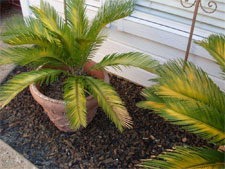
Question: Our sago palms have serious yellowing on their leaves. We’ve used a high-nitrogen fertilizer, and we’ve watered them very infrequently. What are we doing wrong? C. and J. C., no city given.
Answer: This is either sunscald or drought damage, possibly a mix of both. Sago palms are not succulents that grow in arid areas. While they need well-draining soils, they also need a constant supply of moisture. They’ll also do best if they’re in bright shade, with no direct sunlight during the 9 a.m. until 6 p.m. part of the daytime. Do check, also, for spider mites. They will cause tan mottling on the leaves. This doesn’t really look like spider mite damage, but you should double-check to be sure. Thump one of these leaves over a sheet of white paper. If almost microscopic spots start to move, those would be the mites. Apply a general-purpose insecticide to control them.
Question: I bought 55 one-foot Thuja ‘Green Giant’ plants in early spring. I have fertilized them with camellia food every three months. I give them a gallon of water every three days (now every two days). What more can I do?
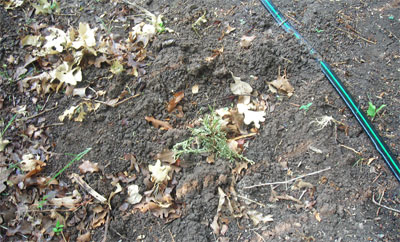
Answer: Oh, my. My experiences, and those of many others, with this type of arborvitae have not been stellar. I’ve tried it twice (won’t again), and mine died slowly over the first summer. Spider mites were partly involved (see answer to prior question), but they also didn’t like the heat. It really looks like your plants have gotten way too dry. While one gallon every three (or two) days should be adequate for one-foot plants, the problem may already have existed before you started watering at that frequency. Honestly, if you’re using this soaker hose that I see in the photo to water them, it’s too far away from their roots. You also didn’t mention if your plants were in one-gallon pots when you got them. Hopefully they were not bare-rooted. Even with one-gallon plants, I’d be very concerned setting them directly into the landscape. I find plants that are 18 to 24 inches tall, and that have 3- or 5-gallon root balls have much greater margins of error when it comes to watering. A few hours of dry soil with small plants like these, and they’ll be toast. Sorry to be so harsh with the answer, but I owe you the best advice I can give.
Question: Is this chinch bug damage? I saw a few earlier this summer, and I applied a granular insecticide. But, the areas keep getting larger. V.R., Burleson.

Answer: Wow! That’s really bad looking. I would really not suspect chinch bugs because the damage is spreading in spite of your treatment, and also because this problem seems to prefer the bermudagrass. (Chinch bugs are much more troublesome with St. Augustine.) I wanted a more definitive answer, so I sent the photo to my 34-year plant pathology associate and friend, Dr. Phil Colbaugh, retired from the Texas Agricultural Experiment Station. Phil took the liberty of marking up your photo. You’ll see reference to his markings in his reply:
"Neil, I looked at this image and thought the area looked like low spots in the lawn, and thus areas for irrigation water to accumulate … particularly where you use a spot sprinkler and not a landscape irrigation system. Sometimes we just forget and the area gets totally saturated. I do think this is some sort of a soil-borne disease, and my best guess would be a Pythium (water mold) root rot disease, as they are quite active now. I would advise getting a professional diagnosis of the problem to make sure, because there are other types of soil-borne diseases active now as well. You can wash down a small core of this turf to compare a healthy area and a diseased area to see if the roots are white (healthy) or turning brown (diseased). The reason I think this is a soil-borne disease is that I can see the advancing front marked in red on the photo you sent today. I would think the problem would be common on areas with heavy clay soils that do not drain well.
Always good to hear from a good colleague and friend. Phil"
I would suggest the Plant Disease Diagnostic Laboratory at Texas A&M. Here is a link to their website. http://plantclinic.tamu.edu/ Click on "Services" to see about sending a sample. Good luck!
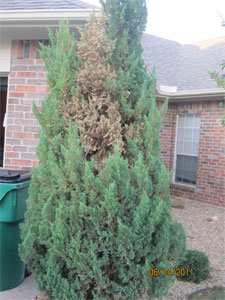
Question: My junipers are not doing well. I was told they were too far gone to be saved, and that I’d need to plant new trees. Can they be cut back and the dead spots removed? Even if they wouldn’t be pretty for years, the cost of taking them out and replacing them doesn’t fit into my budget. Any other suggestions? V., Rockwall.
Answer: I do see a few bagworms in your photo, but this really does look more like Phomopsis twig blight. It’s a serious and difficult disease that has ravaged many Blue Point and other junipers in North Texas in recent years. Here is a link to information on juniper diseases.
You might want to send a sample to the Plant Disease Diagnostic Laboratory at Texas A&M. Again, that website is http://plantclinic.tamu.edu/
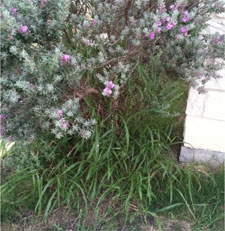
Question: What can I use to kill johnsongrass that’s mixed in with my Texas sage? It’s almost impossible to pull it up. N.C., Moody.
Answer: Use one of the glyphosate weedkillers such as the original Round Up. Be careful to buy a product that contains only glyphosate and no additional herbicides. Spray it with a hand-held sprayer, and use a large piece of cardboard to shield the Texas sage from the spray. You could also buy a plastic drop cloth and completely cover the plant (when it is not in the sun) while you spray. The glyphosates are not active in the soil, so you only have to worry about keeping the spray off the leaves and stems. One or two treatments should eliminate the johnsongrass. You could follow up a week or two later with a roll-type mulch cut and fit around the base of the shrub to prevent regrowth. Cover it with bark mulch to let the area look better.
Question: We have two Chinese pistachios planted in front of our house. They were set out in 2005 from 65-gallon pots. The bark on the south-most branch is splitting, and sap is starting to ooze. Is this the result of the severe winter and extreme summer? Overall, the tree is beginning to show signs of struggling.
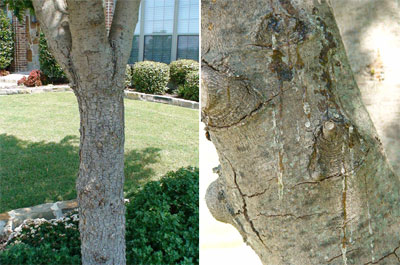
Answer: This doesn’t look good. There is some type of damage to the internal wood, but I’d be more tempted to think it is left over sunscald from prior summers. Thousands of pistachios in Texas went through the summer of 1980 and the winter of 1983-84 without damage, so I don’t think this is specifically due to recent weather. You really should have a certified arborist take a look at your tree. It’s worth the investment, and as good as your photos are, a little gentle exploring is probably in order. Good luck with it.
Question: My husband sprayed weedkiller on some shoots of the crape myrtle plant and a weedy shrub we’re trying to eliminate. Will the weedkiller work its way into the mother plant? As you can tell, it’s a very important plant to us. What can I do besides pray? J., Carrollton.
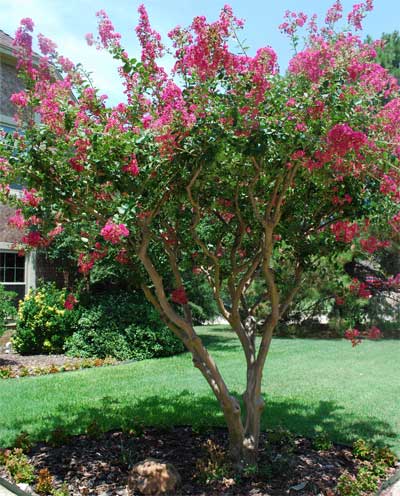
Answer: It looks like this was done a week or two before the photo was taken, so I’m going to assume that it just burned the leaves with which it made contact. While there are herbicides that are active in the soil and that might have been taken into the mother plant’s root system, he probably wouldn’t have applied enough to do harm. Keep the tree moist the remainder of the summer. Hopefully, not much made contact with the main tree. It’s hard to give a definitive answer without knowing the weedkiller involved, how it was applied and in what quantity.
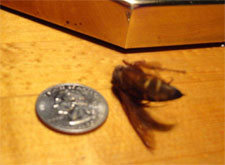
Question: What are these large insects, and do I need to worry about them? They do not seem to be aggressive, but I see a stinger. We’re finding them burrowing in our yard. I want to get rid of them. D.M., Irving.
Answer: You have cicada killers. They are beneficial, and they are docile. I’ve not heard of anyone being stung by them. I walk right through them in my own garden, because I like the fact that they are predators on the noisy cicadas (locusts). I’m sure insecticides will kill them, but I’m really hoping you’ll not feel the need to do so. They are your friends.
Question: For several years, we’ve had a circular area around a small red oak. No grass grows in that area. It began as a small patch, but now it’s worked its way around the tree. No matter how much we water, the soil remains bare. Any help would be appreciated. A.R., Midlothian.
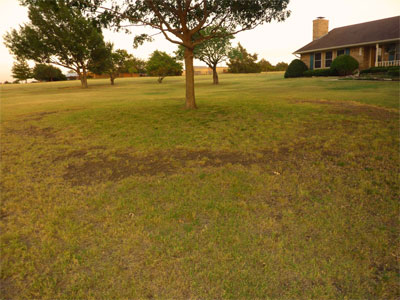
Answer: I have to admit that when I clicked to open your photo, I expected to see a bare area right around the trunk of the tree – I see some variation of that photo a dozen times a week. Your photo blew me away. This is really unusual, and I’m going to resist the urge to accuse you of tying your horse to the tree with a 15-foot rope. I’m going to take a leap of faith and offer the guess that you might have a very unusual fairy ring. These circular areas are where mushrooms develop. It starts with a spot, then, like ripples on a pond, the mushrooms develop farther and farther out over successive years. Rarely is it in a full circle, and rarely does it do anything worse than causing a darker green circle in the turf. So, now it’s time to ask if you have ever seen mushrooms near this circle. If not, I’m done. If it isn’t a fairy ring, it almost has to be some type of mechanical injury (probably traffic), an extra pass with a weed-and-feed fertilizer to the point of causing damage to the grass, or some other odd problem. You win the prize with this one!
Question: I’ve had this Lady Banksia rose on this arbor since 2001. In the past three years, it’s grown thin on its sides. Is the rampant top growth causing too much shade on the sides? I’d like to get rid of it and plant something that would bloom more of the year, plus I’m tired of the long shoots. Suggestions? S.L., Farmers Branch.
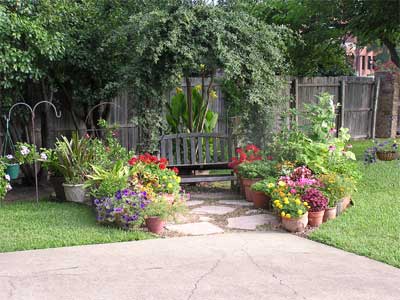
Answer: Yes, on the shading. As for another vine to grow on the arbor, it will need to be a fairly refined vine. The arbor isn’t big enough to handle most climbing roses. Carolina jessamine is a refined grower, but it, too, is a spring-only bloomer. An annual vine like morning glories or hyacinth beans would be pretty during the growing season. Sea Foam and Climbing Pinkie are both EarthKind® roses, as identified by Texas A&M research. These are the "bullet-proof" roses that grow with lowest maintenance of any roses. Both of these are listed as "mannerly climbers." Here is a link to the list: http://aggie-horticulture.tamu.edu/earthkind/roses/cultivars/
Question: Two years ago, a landscaper planted three Japanese yews in front of our house. Within several months, one had died. We had it replaced the next year, and the replacement died within a matter of months. In early May this year, we planted Number 3. Now, you can see that it, too, has died. Any clues from the photo?

Answer: I’ve been around Japanese yews all of my life. I’ve even grown my share of them. I have never seen an insect or disease bother them. However, I’ve found that they are very unforgiving of several things: drought; really hot, reflective sunlight; poor drainage; and just transplanting in general. I’ve had pretty good luck with them when I bought container-grown plants with all of their roots intact, but I’ve lost several when I first tried to buy balled-and-burlapped plants. I’m not sure what the answer to your specific situation is, but it’s in these notes above somewhere.
Question: This photo is of a large-fruiting tomato plant from our spring garden. It had three nice, large fruit. The photo was taken a couple of weeks ago, and I’m wondering why it has gone for well more than a month without flowering or, therefore, producing any fruit. My cherry tomato plant has done tremendously. F.S., no city given.

Answer: Large-fruiting tomatoes should never be sold in Texas. They won’t set fruit when temperatures go above 90 degrees, so you’re lucky that you got the three fruit. Many people get nothing. Cherry tomatoes will set fruit well into the summer. It’s all just a physiological thing.
Question: I planted four trees in my back yard in 1995. Two were ornamental pears, one was a Kieffer pear, and the fourth was a Bartlett pear. Now, they are dying. I was told by my Extension Service office that cotton root rot was the cause. What is cotton root rot? How does it spread? Are there plants that don’t get it? A.B., no city given.
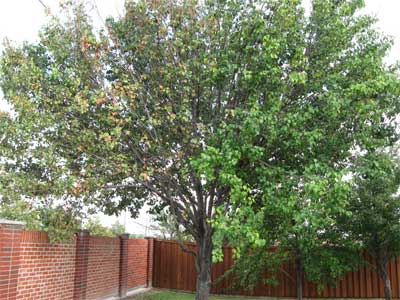
Answer: Cotton root rot is a soil-borne fungus that will be dormant in the soil for many years, finally rising up and killing susceptible plants. It’s been known to be a problem in Texas’ alkaline soil areas for more than 100 years, and it’s one of the prime reasons you don’t see cotton being grown in the Blackland Prairie much any more. As you might guess, the cotton family (cotton, althaea, hibiscus, okra and others) is highly susceptible. Even more so, however, apples, pears, Indian hawthorns and other members of the rose family seem predestined to die from it. It spreads slowly through the soil, often just a few inches per year. Plants that are highly resistant or immune to it: hollies, crape myrtles, nandinas, junipers, cedar elms, pecans and oaks.
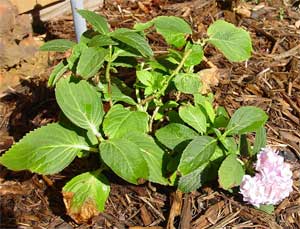
Question: I planted this Endless Summer hydrangea in May. It gets sun from 9 until 11:30, then dappled shade. I followed all the directions for planting, mulching and feeding it. It’s now producing pink flowers instead of the blue, but I’ll add the aluminum sulfate later. Pink is just fine for now. My biggest concern is of the leaves that are turning brown. What am I doing wrong that might be causing this issue? M.H., The Colony.
Answer: Hydrangeas struggle with the North Texas heat. They also don’t fare well in the sun, and they must have moist, highly organic soils. Assuming you’re keeping it moist, my bet is that it’s getting too much sun. If you stand out in the sun at 11:30 these current mornings, you’ll soon be suffering. It needs more shade. Consider transplanting it late this coming winter.

